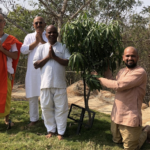At a reading in New York recently to launch his new book Becoming a Mountain: Himalayan Journeys  in Search of the Sacred and the Sublime, Indian-born American Stephen Alter said that he was looking forward to his upcoming trip to Pakistan in August, to climb K-2.
in Search of the Sacred and the Sublime, Indian-born American Stephen Alter said that he was looking forward to his upcoming trip to Pakistan in August, to climb K-2.
Alter, like his actor cousin Tom Alter for whom he is often mistaken, was born and schooled in India. Children of missionary parents, they have lived in India all their lives and speak fluent Urdu/Hindi.
His latest book is his account of a series of treks in the Himalayas after recovering from an attack in 2008 that he and his wife miraculously survived. The yet-unsolved assault that took place at his life-long home in the hill station of Mussoorie in the foothills of the Himalayas led him to question his own sense of belonging as a third-generation American in India.
Alter is also the author of Amritsar to Lahore: A Journey Across the India-Pakistan Border (2001), written after two visits to Pakistan.
“During the course of my journey, many of the people I met in Pakistan and India expressed a curious combination of affection, indifference, and animosity toward their neighbors across the border… The border divides them but it is also a seam that joins the fabric of their cultures,” he wrote.
He first crossed the border between India and Pakistan in 1997, the fiftieth anniversary of Partition, going from New Delhi to Lahore. During his journey, he retraced the legendary route of the Frontier Mail toward the Khyber Pass, and returned by bus along the Grand Trunk Road, stopping along the way.
During this journey and another in 1998, Alter interviewed people from all classes and castes: Hindus, Muslims, and Sikhs, men and women. The book includes diverse interviews, conversations, and oral histories, with Alter’s informed commentary raising questions about national and individual identity, the territorial imperatives of history, and the insidious mythology of borders.
In his India-Pakistan book, Alter reflects intimately upon India’s past and present as a special observer who is an insider as well as outsider. His encounters illustrate the shared culture and heritage of South Asia, as well as the suspicions and intolerance that exist across both countries. The narrative includes discussions of the works of South Asian novelists, poets, and filmmakers who have struggled with the issue of identity across the borderlands.
— aka








